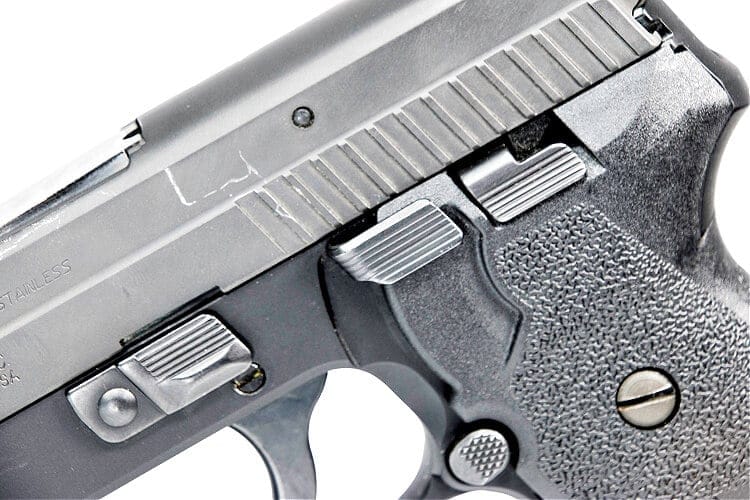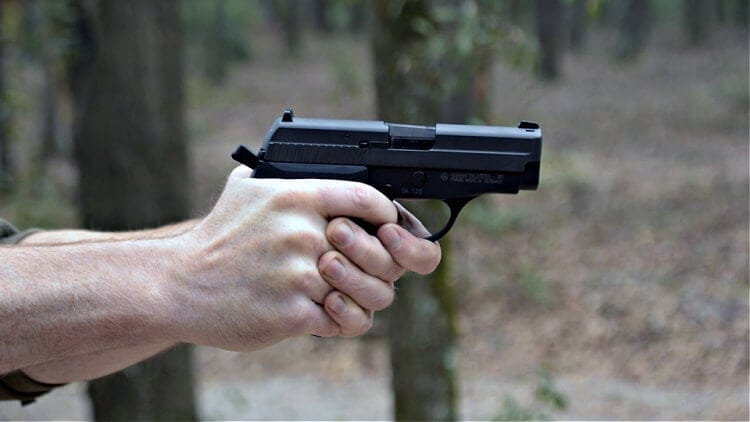I was a long-time fan of SIG’s all-metal handguns long before the introduction of the Sig P239 pistol. Developed in response to American civilian’s need for compact, concealed-carry pistols in full-power calibers, the Sig Sauer P239 was initially fairly popular.
While large and overly-heavy by today’s standards, in the mid-90’s the P239 was SIG’s smallest, lightest offering chambered in a military cartridge. Their next closest pistol being the P232, a direct-blowback handgun chambered in .380 ACP and .32 ACP. The P232 was actually longer than the P239 and nearly as heavy.
The P239 saw reasonable commercial success until a few short years ago, when lighter, higher-capacity polymer-framed pistols rose in both popularity and availability. Truth be told, it’s hard for an all-metal, single-stack design like the P239 to compete with modern offerings not just from competitors, but from SIG itself.
Ultimately the gun was discontinued in 2018, but before we get into that, let’s first explore all the features of the P239.
This article is from October 2018.
Sig Sauer P239 Features
The SIG P239, is a locked-breech, magazine-fed, semi-automatic handgun chambered in 9mm, .40 S&W or .357 SIG. It feeds from single-stack, phosphate-coated magazines. These mags hold either eight or ten rounds in the 9mm version or seven or eight rounds in both the .40 S&W and .357 SIG models.

SIG’s single-stack sidearm features nearly identical controls to its double-stack magazine-fed big brothers, the P229 and P226. And just like these two handguns, the P239 features similar angular cuts on its steel slide, which ride on a black, anodized aluminum frame.
This single-stack SIG features the same non-ambi controls as the rest of the SIG handgun line at the time. This means a slide-stop followed by an oversized decoking lever and finally a disassembly lever.

Also like other SIG handguns, it features the old-school, “dot the I” sight setup SIG was known for. The barrel, too, is very SIG. It has the same John Mosses Browning linkless cuts as the HiPower introduced decades before.
Size Matters
As I mentioned previously, the P239 is a compact pistol in name only. Measuring six and a half inches long, 5.1 inches high, and 1.2 inches thick, the gun is fairly chunky for a concealed carry piece. For reference, a Glock 19 is only a quarter-inch longer, .06 inches shorter, and .06 inches thicker than the P239 making the P239 about as concealable, but with half the magazine capacity.

Worse yet, the P239 weighs four ounces more than the Glock 19 unloaded. And on top of that, the Glock 19 features nearly half an inch more barrel, meaning better ballistic performance from its rounds.
Outdated From Inception
Maybe the SIG P239 can’t hold its own today when compared to more modern firearms, but that surely wasn’t the case when it was introduced, was it?

Sadly, when the P239 hit the American market in 1996, Glock’s model 19 compact had been available for eight full years. Which begs the question, “Why was the gun introduced in the first place?”
Honestly, it probably has to do with SIG-lovers wanting a more concealable option than the P229. The P239 is nearly half an inch shorter and five ounces lighter. So in that sense, the P239 is a success. Though, I would have personally loved it if SIG had found a way to widen the frame slightly so it could accept double stack magazines.
Background
The model in this review belongs to my wife, who purchased it in Massachusetts prior to the expiration of the Assault Weapons ban. At that time, single-stack pistols made more sense, as they were physically thinner, and the limited capacity wasn’t a hindrance due to restrictive laws in the state.

I had taken her to a half dozen different gun ranges and had her try out various pistols to see which felt best in her hands. She liked the P229, but the only models available at stores were loaded with features, and thus prohibitively expensive.
She also really liked the grip angle and feel of 1911s, but given her petite size, there was no way she’d be able to conceal one on her. She also tried a used Glock 26, but it was a little too snappy for her, and way too expensive.
Confused?
In Massachusetts, Glocks are banned by the Attorney General, by name. Thus, only grandfathered pistols and a few exceptions were permitted. This created a similar situation to pre-86 machine guns, where the price of an otherwise affordable firearm is artificially inflated to stratospheric levels.
So much so, that when I left the state around 2010, I sold my used Gen 2 Glock 17 for $800 with three magazines. If that wasn’t bad enough, the frame featured a tear in the magazine well from a previous owner. (How exactly one manages to tear the polymer frame on a Glock, I will never know.)
Sig Sauer P239 Performance
Like most SIG handguns, the P239 is remarkably accurate — especially for its 3.6-inch barrel. In testing, the gun easily landed rounds on a human-sized silhouette target from ShootSteel.com at 120 yards. The same could be said of its ability to keep all rounds in the black on a standard NRA pistol target at both 25 and 50 yards. Of course, this is difficult given its short sight radius. But if the shooter does their part, the gun will shoot straight as an arrow.

In terms of reliability, the Sig Sauer P239 wasn’t quite as successful. It seemed to gleefully consume all manner of 9mm Luger ammunition, provided that ammo was FMJ or ball ammo. Certain defensive rounds like the ones from Winchester tended to jam against the top of the chamber. These failure to chamber malfunctions were rare but too common to trust for concealed carry.
That said, I was able to resolve the issue by applying some flitz polish to a soft Dremel head and working the area over.
Overall
SIG’s P239 pistol isn’t a bad gun by any measure. It’s reliable, accurate, and well-balanced. That said, it’s lacking in multiple areas such as capacity, trigger pull, and price that make it a hard sell in a market saturated with less expensive, lighter weight, more capacious options.

If a shooter likes the feel and balance of the P239, it will serve them well – no doubt. But shooters considering the hefty compact pistol for concealed carry should give other pistols a more serious look first. But if you’ve got to have a SIG, and the P229 is just too bulky for you, the Sig Sauer P239 will hit all the right notes.



I’ll take the accuracy of my P239 over a Glock any day. Mag size is overrated for CCW applications.
In a CCW situation at close range, accuracy and shot placement for the first 2-3 shots is most critical. Who wants a running gunfight? Look at the church shooting in Texas – one well placed shot to the head.
I find the 239 easier to shoot and more accurate than my 229. It’s my goto gun.
Very similar to the 225 (original German version) but more rounded for CCW.
The 239 SAS version is more melted and smoothed for CC. And I am not sold on plastic striker fired guns. Too many issues keep showing up. Much prefer the exposed hammer as an additional safety.
Big +10 on your ” Plastic Striker Fired” comment………totally agree. I don’t hide my dislike of plastic guns……..but I’ll never figure out how those unreliable striker guns became popular.
I’ve had my 239 9mm for several years while many other handguns have come and gone. It just works and feels solid. I have a Glock 19 and I don’t care what the numbers look like, the 239 is easier to conceal and snags less. I shoot FMJ at the range with it but have run a box or two of JHP through it and had no jams. I’d trust it any day. Also agree with mag capacity being overrated – if you haven’t hit what you’re aiming at after 7 rounds, you better save that last one and run.
My favorite pistol,in .40 and if i cant get it done in 8 rounds i better rurn
I am no shooter, but carried concealed for about ten years. I was always top of the qualifying class at 25 yards with the P239. (Yes, CA makes qualifying for a CCW difficult.) I just had the barrel replaced, and the sights refurbished two years ago, and the gun is like new. The P239 will always be my CCW.
I must like this pistol – SAS, Tac, and Scorpion, all in 9mm. Accurate, and, with suppressor, the Tac is a dream.
Carried one off-duty for a decade or so…
Agree with most of the commenters.
Have had mine since 2009. Never a problem at all. Very accurate. Stainless steel slide is about as heavy as the longer carbon steel one on my 1989 P-226.
But then, the slide was designed to shoot .357 SIG and .40 S&W as well. One small concern; for longer bullets, like the all copper Cor-Bon DPXs, the nose of the next bullet in the magazine does press against the magazine well so that it does not fall out when the release is pressed. Not a problem since I always use my off hand to catch the mag or pull the mag out anyway then slightly pull the slide back to disengage the slide lock and load a round from the next magazine. And the hollow-point opening on the DPX is huge; like the Federal HST. I had mine sent back for the enhanced package which was mostly polishing the trigger surfaces and feed ramp and chamber. Trigger Smooth as silk now.
Sometimes I shoot the P226 more accurately; other times the P226. Can’t go wrong with either.